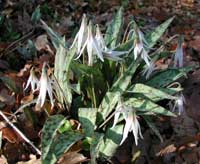Resource Library
Plant of the Week: Troutlily
The University of Arkansas System Division of Agriculture does not promote, support or recommend plants featured in "Plant of the Week." Please consult your local Extension office for plants suitable for your region.
Plant of the Week
Troutlily
Latin: Erythronium albidum

Spring is here and the early wildflowers are blooming. Most Ozark woodland wildflowers are what botanists call spring ephemerals - plants that start growth early, do their thing and then disappear before competition for light and water becomes too extreme as the trees leaf out.
One of the first of these to appear is the trout lily or dogtooth violet (Erythronium albidum).
The trout lily is a small plant that grows only about 6 inches tall with a single nodding white flower produced from a slender corm resembling a dog’s fang tooth. Flowering corms produce a pair of 6-inch long, waxy, gray-green leaves that are mottled with irregular patches of brown, giving rise to the common name of “fawn lily.”
About 20 species of Erythroniums are recognized by botanists with these found in eastern North America, a wide swath across Eurasia and in the western United States. According to DNA analysis, morphology and adaptational characteristics, the Eurasian and Eastern American species are closely related. The Western American species are thought to be more modern, and occasionally, hybrid populations are identified, indicating the plants are still in an active process of evolution in the western states.
The eastern species, including E. albidum, produce only one flower per stem, while the western species are capable of producing two or three blooms per stem. Pagoda and White Beauty, two trout lilies commonly offered in the bulb trade, are selections of the western American species and produce a more significant show in the garden than does our small native species.
Another difference between the western American species and the other dogtooth violets is in the manner of seed dispersal. The western species disperse their seeds via means of a kind of catapult system whereas the others employ ants for dispersal in a process known as myrmecochory.
Trout lily seeds contain a structure on the outside of the seed coat called an elaiosome that acts like catnip for various species of ants. About a third of our woodland wildflowers are dispersed by ants.
Art Guppy, an Erythronium expert and close observer of ants, thinks that ants may not actually get much out of the exchange when they disperse trout lily seed. He thinks the elaisome produces a volatile pheromone that triggers something called the “dead corpse response.”
He observed that ants excitedly grab fresh trout lily seeds and carry them away. But, before they get to their nests, they loose interest in the seed and drop it. Other ants pass by and pay it no attention.
According to Guppy’s thinking, this chemical signal tricks the ant into moving the seed away from the parent plant, but not to take it as far as the nest where conditions might be less favorable for its germination and subsequent development.
Trout lilies are found on cool, moist, east or north facing slopes where soil rich in organic matter accumulates. They are slow to establish, but once established in a site, will persist for years. Colonies of trout lilies usually have a mixture of mature flowering corms and immature corms that produce just a single leaf. Plants grown from seeds reach blooming age in three to four years. Seeds need a period of three months of warm moist stratification to allow the embryo to fully mature and then at least 10 weeks of chilling to get the seed to germinate.
By: Gerald Klingaman, retired
Extension Horticulturist - Ornamentals
Extension News - March 31, 2006
The University of Arkansas System Division of Agriculture does not maintain lists of retail outlets where these plants can be purchased. Please check your local nursery or other retail outlets to ask about the availability of these plants for your growing area.